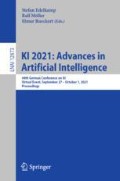Abstract
To improve the accuracy of convolutional neural networks in discriminating between nevi and melanomas, we test nine different combinations of masking and cropping on three datasets of skin lesion images (ISIC2016, ISIC2018, and MedNode). Our experiments, confirmed by 10-fold cross-validation, show that cropping increases classification performances, but specificity decreases when cropping is applied together with masking out healthy skin regions. An analysis of Grad-CAM saliency maps shows that in fact our CNN models have the tendency to focus on healthy skin at the border when a nevus is classified.
Access this chapter
Tax calculation will be finalised at checkout
Purchases are for personal use only
References
Berseth, M.: ISIC 2017 - skin lesion analysis towards melanoma detection. CoRR abs/1703.00523 (2017). http://arxiv.org/abs/1703.00523
Bissoto, A., Fornaciali, M., Valle, E., Avila, S.: (De)constructing bias on skin lesion datasets. In: The IEEE Conference on Computer Vision and Pattern Recognition (CVPR) Workshops, June 2019
Burdick, J., Marques, O., Weinthal, J., Furht, B.: Rethinking skin lesion segmentation in a convolutional classifier. J. Digit. Imaging 31(4), 435–440 (2017). https://doi.org/10.1007/s10278-017-0026-y
Codella, N., Rotemberg, V., Tschandl, P., Celebi, M.E., et al.: Skin lesion analysis toward melanoma detection 2018 (2019). http://arxiv.org/abs/1902.03368
Codella, N.C.F., Gutman, D., Celebi, M.E., Helba, B., et al.: Skin lesion analysis toward melanoma detection: a challenge at the 2017 International Symposium on Biomedical Imaging. In: 2018 IEEE 15th International Symposium on Biomedical Imaging (ISBI 2018), pp. 168–172. IEEE, Washington, DC, April 2018. https://doi.org/10.1109/ISBI.2018.8363547
Curiel-Lewandrowski, C., Novoa, R.A., Berry, E., Celebi, M.E., et al.: Artificial Intelligence Approach in Melanoma. In: Fisher, D., Bastian, B. (eds.) Melanoma, pp. 1–31. Springer, New York (2019). https://doi.org/10.1007/978-1-4614-7322-0_43-1
Deng, J., Dong, W., Socher, R., Li, L.J., et al.: ImageNet: a large-scale hierarchical image database. In: 2009 IEEE Conference on Computer Vision and Pattern Recognition, pp. 248–255. IEEE, Miami, June 2009. https://doi.org/10.1109/CVPR.2009.5206848
Esteva, A., Kuprel, B., Novoa, R.A., Ko, J., Swetter, S.M., et al.: Dermatologist-level classification of skin cancer with deep neural networks. Nature 542, 115 (2017). https://doi.org/10.1038/nature21056
Giotis, I., Molders, N., Land, S., Biehl, M., et al.: MED-NODE: a computer-assisted melanoma diagnosis system using non-dermoscopic images. Expert Syst. Appl. 42(19), 6578–6585 (2015). https://doi.org/10.1016/j.eswa.2015.04.034
ISIC: International Skin Imaging Collaboration. https://www.isic-archive.com/
Kawahara, J., Hamarneh, G.: Visual diagnosis of dermatological disorders: human and machine performance, June 2019. http://arxiv.org/abs/1906.01256
Krizhevsky, A., Sutskever, I., Hinton, G.E.: ImageNet classification with deep convolutional neural networks. In: Advances in Neural Information Processing Systems, vol. 25, pp. 1097–1105. Curran Associates, Inc. (2012)
Marchetti, M.A., Codella, N.C., Dusza, S.W., Gutman, D.A., et al.: Results of the 2016 international skin imaging collaboration international symposium on biomedical imaging challenge. J. Am. Acad. Dermatol. 78(2), 270-277.e1 (2018). https://doi.org/10.1016/j.jaad.2017.08.016
Masood, A., Ali Al-Jumaily, A.: Computer aided diagnostic support system for skin cancer: a review of techniques and algorithms. Int. J. Biomed. Imaging 2013, 1–22 (2013). https://doi.org/10.1155/2013/323268
Nguyen, D.M.H., Ezema, A., Nunnari, F., Sonntag, D.: A visually explainable learning system for skin lesion detection using multiscale input with attention U-net. In: Schmid, U., Klügl, F., Wolter, D. (eds.) KI 2020. LNCS (LNAI), vol. 12325, pp. 313–319. Springer, Cham (2020). https://doi.org/10.1007/978-3-030-58285-2_28
Nunnari, F., Sonntag, D.: A software toolbox for deploying deep learning decision support systems with XAI capabilities. In: Proceedings of the 13th ACM SIGCHI Symposium on Engineering Interactive Computing Systems. ACM (2021). https://doi.org/10.1145/3459926.3464753
Petsiuk, V., Das, A., Saenko, K.: RISE: randomized input sampling for explanation of black-box models. In: Proceedings of the British Machine Vision Conference (BMVC) (2018)
Qian, C., Liu, T., Jiang, H., Wang, Z., et al.: A detection and segmentation architecture for skin lesion segmentation on dermoscopy images. CoRR abs/1809.03917 (2018). http://arxiv.org/abs/1809.03917
Ronneberger, O., Fischer, P., Brox, T.: U-net: convolutional networks for biomedical image segmentation. In: Navab, N., Hornegger, J., Wells, W.M., Frangi, A.F. (eds.) MICCAI 2015. LNCS, vol. 9351, pp. 234–241. Springer, Cham (2015). https://doi.org/10.1007/978-3-319-24574-4_28
Selvaraju, R.R., Cogswell, M., Das, A., Vedantam, R., et al.: Grad-CAM: visual explanations from deep networks via gradient-based localization. In: The IEEE International Conference on Computer Vision (ICCV), October 2017
Siegel, R.L., Miller, K.D., Jemal, A.: Cancer statistics, 2019. CA: Cancer J. Clin. 69(1), 7–34 (2019). https://doi.org/10.3322/caac.21551
Simonyan, K., Zisserman, A.: Very deep convolutional networks for large-scale image recognition, September 2014. http://arxiv.org/abs/1409.1556
Tan, C., Sun, F., Kong, T., Zhang, W., Yang, C., Liu, C.: A survey on deep transfer learning. In: Kůrková, V., Manolopoulos, Y., Hammer, B., Iliadis, L., Maglogiannis, I. (eds.) ICANN 2018. LNCS, vol. 11141, pp. 270–279. Springer, Cham (2018). https://doi.org/10.1007/978-3-030-01424-7_27
Wahlster, W., Winterhalter, C.: German standardization roadmap on artificial intelligence. Technical report, DIN e.V. and German Commission for Electrical, Electronic & Information Technologies of DIN and VDE (2020)
Winkler, J.K., Fink, C., Toberer, F., Enk, A., et al.: Association between surgical skin markings in dermoscopic images and diagnostic performance of a deep learning convolutional neural network for melanoma recognition. JAMA Dermatol. 155(10), 1135 (2019). https://doi.org/10.1001/jamadermatol.2019.1735
Acknowledgments
The research has been supported by the Ki-Para-Mi project (BMBF, 01IS19038B), the pAItient project (BMG, 2520DAT0P2), and the Endowed Chair of Applied Artificial Intelligence, Oldenburg University (see https://uol.de/aai/. We would like to thank all student assistants that contributed to the development of the platform (see https://iml.dfki.de/).
Author information
Authors and Affiliations
Corresponding author
Editor information
Editors and Affiliations
Appendices
A MedNode Results
Table 3 and Table 4 show the results of the experiments on the MedNode dataset.
B ISIC2016 Results
Table 5 and Table 6 show the results of the experiments on the ISIC2016 dataset.
Rights and permissions
Copyright information
© 2021 Springer Nature Switzerland AG
About this paper
Cite this paper
Nunnari, F., Ezema, A., Sonntag, D. (2021). Crop It, but Not Too Much: The Effects of Masking on the Classification of Melanoma Images. In: Edelkamp, S., Möller, R., Rueckert, E. (eds) KI 2021: Advances in Artificial Intelligence. KI 2021. Lecture Notes in Computer Science(), vol 12873. Springer, Cham. https://doi.org/10.1007/978-3-030-87626-5_13
Download citation
DOI: https://doi.org/10.1007/978-3-030-87626-5_13
Published:
Publisher Name: Springer, Cham
Print ISBN: 978-3-030-87625-8
Online ISBN: 978-3-030-87626-5
eBook Packages: Computer ScienceComputer Science (R0)

